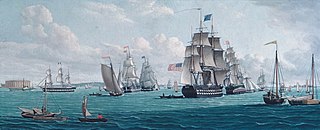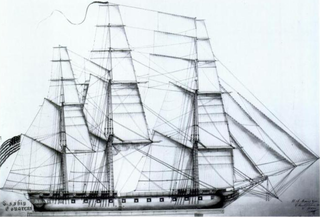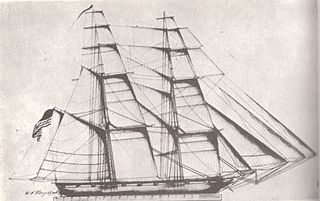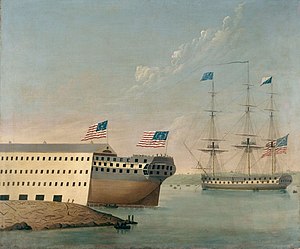
USS Brandywine was a wooden-hulled, three-masted frigate of the United States Navy bearing 44 guns which had the initial task of conveying the Marquis de Lafayette back to France. She was later recommissioned a number of times for service in various theaters, such as in the Mediterranean, in China and in the South Atlantic Ocean.

USS Independence was a wooden-hulled, three-masted ship, originally a ship of the line and the first to be commissioned by the United States Navy. Originally a 90-gun ship, in 1836 she was cut down by one deck and re-rated as a 54-gun frigate.

The third USS Delaware of the United States Navy was a 74-gun ship of the line, named for the state of Delaware.

USS Franklin of the United States Navy was a 74-gun ship of the line. She was named for Founding Father Benjamin Franklin.

The second USS Ohio was a ship of the line of the United States Navy, rated at 74 guns, although her total number of guns was 104. She was designed by Henry Eckford, laid down at Brooklyn Navy Yard in 1817, and launched on 30 May 1820. She went into ordinary and in the ensuing years decayed badly. Refitted for service in 1838, Ohio sailed on 16 October 1838 to join the Mediterranean Squadron under Commodore Isaac Hull. Acting as flagship for two years, she protected commerce and suppressed the slave trade off the African coast. Ohio proved to have excellent performance under sail, repeatedly making more than 12 kn. One of her officers stated, "I never supposed such a ship could be built—a ship possessing in so great a degree all the qualifications of a perfect vessel." In 1840, Ohio returned to Boston, where she again went into ordinary. From 1841 to 1846, Ohio served as receiving ship.

USS Congress was a nominally rated 38-gun wooden-hulled, three-masted heavy frigate of the United States Navy. James Hackett built her in Portsmouth New Hampshire and she was launched on 15 August 1799. She was one of the original six frigates whose construction the Naval Act of 1794 had authorized. The name "Congress" was among ten names submitted to President George Washington by Secretary of War Timothy Pickering in March of 1795 for the frigates that were to be constructed.Joshua Humphreys designed these frigates to be the young Navy's capital ships, and so Congress and her sisters were larger and more heavily armed and built than the standard frigates of the period.

USS Constellation was a nominally rated 38-gun wooden-hulled, three-masted frigate of the United States Navy.

USS President was a wooden-hulled, three-masted heavy frigate of the United States Navy, nominally rated at 44 guns. She was launched in April 1800 from a shipyard in New York City. President was one of the original six frigates whose construction the Naval Act of 1794 had authorized, and she was the last to be completed. The name "President" was among ten names submitted to President George Washington by Secretary of War Timothy Pickering in March of 1795 for the frigates that were to be constructed. Joshua Humphreys designed these frigates to be the young Navy's capital ships, and so President and her sisters were larger and more heavily armed and built than standard frigates of the period. Forman Cheeseman, and later Christian Bergh were in charge of her construction. Her first duties with the newly formed United States Navy were to provide protection for American merchant shipping during the Quasi War with France and to engage in a punitive expedition against the Barbary pirates in the First Barbary War.
USS New York was a three-masted, wooden-hulled sailing frigate in the United States Navy that saw service during the Quasi-War with France.

USS Syren was a brig of the United States Navy built at Philadelphia in 1803. She served during the First Barbary War and the War of 1812 until the Royal Navy captured her in 1814. The British never commissioned her but apparently used her for a year or so as a lazaretto, or a prison vessel. She then disappears from records.

Commodore Arthur Sinclair was an early American naval hero, who served in the U.S. Navy during the Quasi-War with France, the First Barbary War and in the War of 1812. His three sons also served in the Navy; they resigned in 1861, however, to serve in the Confederate Navy.

USS Lynx, a 6-gun Baltimore Clipper rigged schooner, was built for the United States Navy by James Owner of Georgetown, Washington, D.C., in 1814, intended for service in one of the two raiding squadrons being built as part of President James Madison's administration’s plan to establish a more effective Navy, one capable not only of breaking the British naval blockade, but also of raising havoc with the British merchant marine.

Nautilus was a schooner launched in 1799. The United States Navy purchased her in May 1803 and commissioned her USS Nautilus; she thus became the first ship to bear that name. She served in the First Barbary War. She was altered to a brigantine. The British captured Nautilus early in the War of 1812 and renamed her HMS Emulous. After her service with the Royal Navy, the Admiralty sold her in 1817.
The second USS Ontario was a three-masted, wooden-hulled sloop of war in the United States Navy, bearing 16 guns, and saw service during and following the years of the War of 1812 and in the Second Barbary War. Ontario was built by Thomas Kemp, Baltimore, Maryland, in 1813; blockaded in Chesapeake Bay through the War of 1812; and sailed from New York for the Mediterranean on 20 May 1815, Master Commandant Jesse D. Elliott in command.

The first John Adams was originally built in 1799 as a frigate for the United States Navy, converted to a corvette in 1809, and later converted back to a frigate in 1830. Named for American Founding Father and president John Adams, she fought in the Quasi-War, the First and Second Barbary Wars, the War of 1812, the Mexican–American War and the American Civil War. At the end of her career, she participated in the Union blockade of South Carolina's ports. She then participated in the raid on Combahee Ferry that Harriet Tubman, the former slave and Union operative, organized with Union colonel Montgomery. John Adams led three steam-powered gunboats up the Harbor River to Port Royal. The squadron relied on local black mariners to guide it past mines and fortifications. The squadron freed 750+ slaves and unsettled the Confederacy. Tubman was the first woman in U.S. history to plan and execute an armed expedition.

USS Guerriere was the first frigate built in the United States since 1801. The name came from a fast 38-gun British frigate captured and destroyed in a half-hour battle by USS Constitution on 19 August 1812. This victory was one of the United States' first in the War of 1812.
USS Java was a wooden-hulled, sailing frigate in the United States Navy, bearing 44 guns. She was named for the American victory over HMS Java off the coast of Brazil on 29 December 1812, captured by the Constitution under the command of Captain William Bainbridge. HMS Java had suffered severe damage during the engagement and being far from home port was ordered burned.

USS Erie was a three-masted, wooden-hulled sloop-of-war of the United States Navy in the early 19th century.

The Mediterranean Squadron, also known as the Mediterranean Station, was part of the United States Navy in the 19th century that operated in the Mediterranean Sea. It was formed in response to the First and Second Barbary Wars. Between 1801 and 1818, the squadron was composed of a series of rotating squadrons. Later, squadrons were sent in the 1820s to the 1860s to suppress piracy, primarily in Greece and to engage in gunboat diplomacy. In 1865 the force was renamed the European Squadron.

USS Spark was a heavily armed brig in the services of the United States Navy, built for service in the War of 1812. However, she was completed too late for that war and was assigned, instead, to the Barbary Wars in the Mediterranean. After two voyages in support of that action, she was assigned to suppress pirates in the Caribbean, where she was successful in capturing a number of pirate ships and their crews.

















